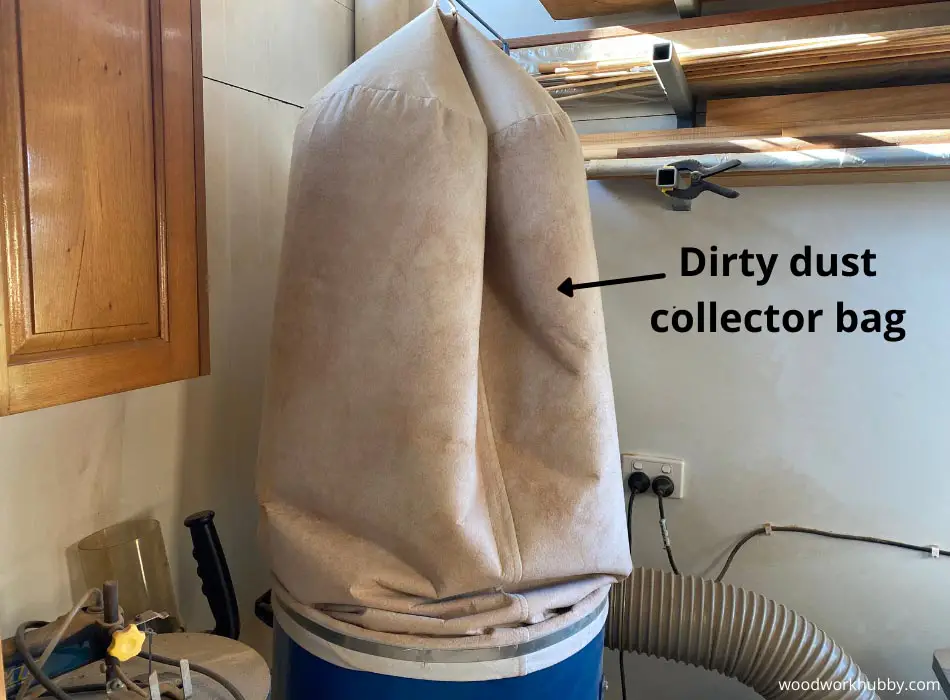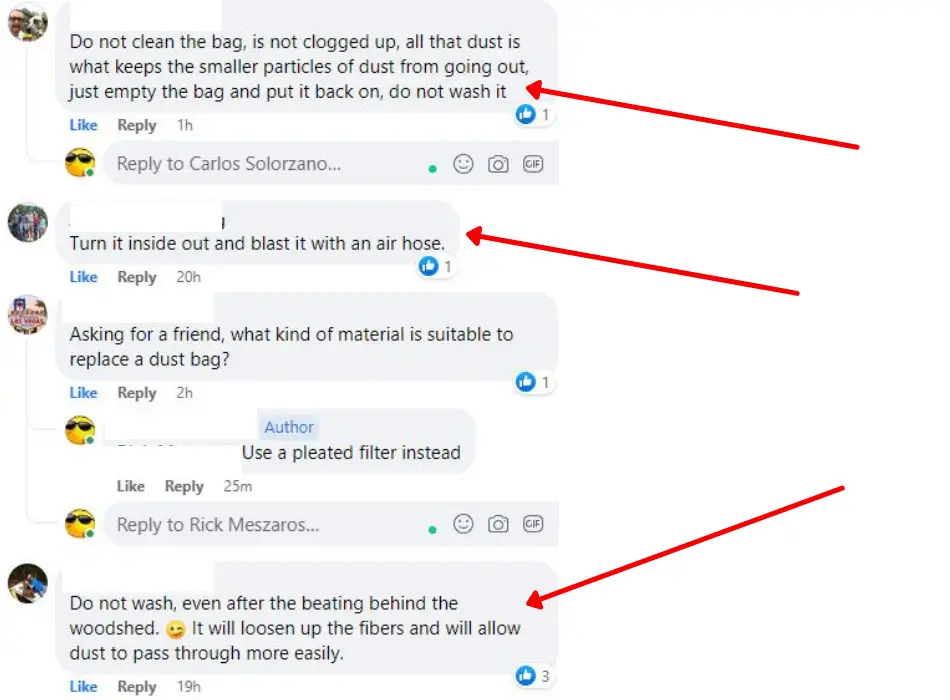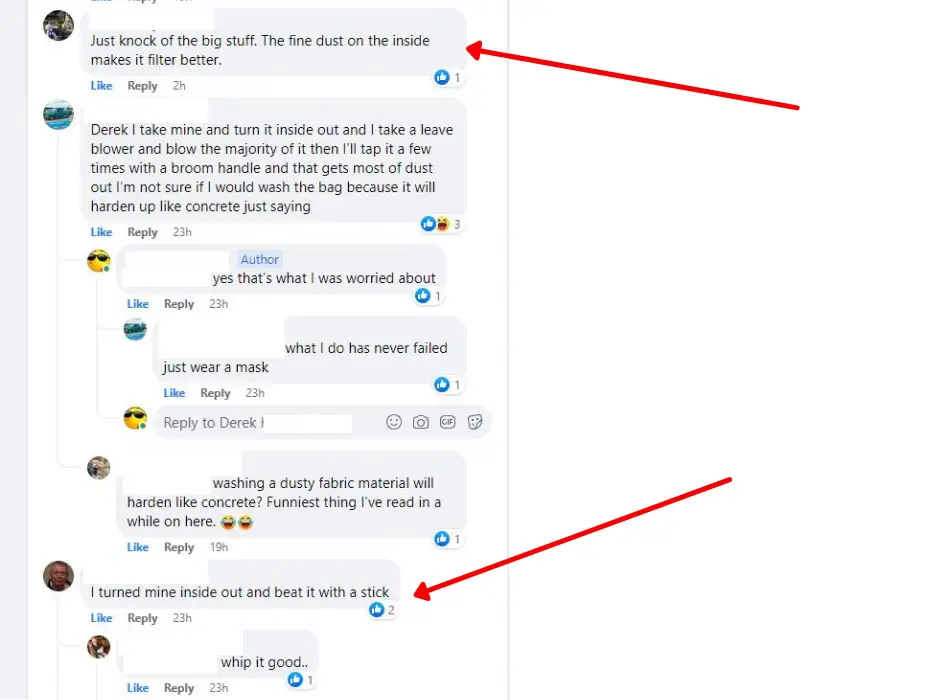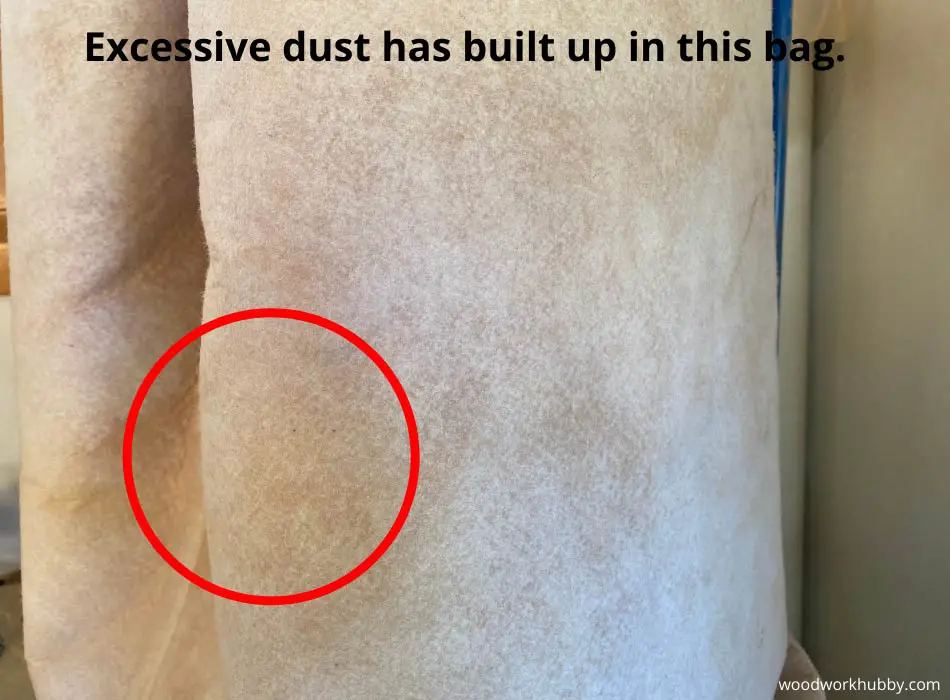I recently wrote a few articles on cleaning dust in your workshop and recommended having a dust collection system in your apartment workshop. Most reader feedback from those posts is about cleaning the dust bags, and more importantly, can you wash dust collector bags?
In general, dust collector bags should NOT be washed as washing can damage the micron rating of the dust bag. The dust coating on the inside of the bag helps filter the finer dust. It is recommended to blow compressed air from the outside, every month with occasional use.
In this article, I cover the different types of dust collector bags and whether they are able to be washed. I have compiled this in a handy table for your reference.
Can Bag Filters Be Washed?

Bag filters should not be washed as you will remove the dust coating on the inside of the bag which helps filter finer dust. The micron rating can also be damaged if washed.
That said, bag filters could be washed if the manufacturer advised so. In my personal experience, bags are always left unwashed and are simply blown out with compressed air.
Here is what some Woodworkers say within a popular Facebook Group.


What Is A Micron Rating On Dust Collector Bags?
A Micron is a micrometer, which is a thousandth of a millimeter! Microns are basically a unit of measure (pore size) of how tight the woven fabric material is, and what size dust particles will be retained by your dust collector bag.
I thought I should include this so you understand what Microns mean. More on micron ratings here.
Be sure to check out what the best dust collectors for MDF are.
Are Dust Collector Bags Washable?
On average, dust collector bags should not be washed as you can damage the bag’s micron rating. Dustbags should be cleaned using compressed air blowing the dust from the outside in.
If you really must wash your dust collector bag, then here is a guide on how to wash the different types of bag materials.
| Dust Bag Material | Washability | Washing Instructions |
|---|---|---|
| Woven Cotton | Handwash | Handwash woven cotton dustbag with cold water and minimal exposure to heat even during the drying process. Do not tumble dry. |
| Polyester | Machine Washable | Polyester bags can be machine washed after being removed. Warm water is ideal for cleaning polyester. |
| High-Efficiency Felt | Handwash | Hand wash with care and use room-temperature water to minimize the risks of hot and cold washing. Use a low-impact detergent. |
| Polypropylene | Tub wash | You can wash this fabric with hot water, though the water should not be too hot as the material is plastic and can melt. Washing in a tub or by hand is crucial, and the bag should not be exposed to a machine at any point from washing to drying. |
| Nylon | Machine Washable | Cold wash this in a machine on the “gentle” setting. Nylon is a forgiving fabric, but you should still be cautious. If the fabric gets caught in a corner or gets tangled with other clothes, it might get torn. |
| Acrylic | Machine Washable | This is one of the most forgiving fabrics and can be machine-washed in room-temperature water, warm water, or cold water. You must make sure the extra dust is removed by blowing air before the bag is put in the machine. |
| Fiberglass | Avoiding Advisable | Wear gloves and a spot-clean fiberglass bag. Avoid washing unless absolutely necessary. |
You can bookmark this post to have access to the table above whenever you need it. But you don’t need the entire table. If you know which material your dust collector bag is made from, you can simply memorize the washing instructions.
Did you know that you could be reducing your CFM with the wrong size ducting? See my article showing what is the best pipe size for harbor freight dust collectors?

To be sure of the bag material, you should Google the dust collector and read its product specifications. These usually include the source matter information. If the information is missing, you can call the manufacturer or ask a question on the Amazon product page.
I highly recommend replacing your dust bag with a pleated filter!
Pleated filters allow your dust collector to work more efficiently and they also filter out the finer dust rather than pushing it out into the air you’re trying to breathe. These do cost around $300-$400 and this is the pleated filter that I used available at Amazon.
See the below video showing why.
When Should I Replace My Dust Collector Bag?
You should replace your dust collector bag if its surface is contaminated, its size has shrunk, or its efficiency has decreased. In the absence of these three reasons, you can keep cleaning the bag and reusing it.
At some point, cleaning will not just remove the dust but also the coating of the bag reduces the pore size, and increases the collector’s micron rating. When such a coating is absent, you need to run the collector longer for it to pick up finer dust. That’s because the pores need to get clogged a little with larger chunks before the opening is small enough to trap lower-micron particles.
This loss in efficiency will not bother you much initially, but after a few washes, you might notice that the extended vacuuming time is not worth delaying the bag replacement. That is a good point to replace your dust collector bag.
Drum sanders produce a lot of dust going into your dust collector. Read my article on what the best dust collectors for drum sanders are.
How Do You Clean A Shop Vac Bag?
To clean a shop vag bag, you can use a leaf blower or compressed air to blow the air from the outside towards the bag’s interior. This removes the dust from the fabric. You can then open the bag and dump the dirt. Washing the bag is optional and usually not recommended.
Here is the method that I use to clean my dust collector bag and have done for many years with great success:
- Take a scrap piece of flat wood and gently hit the outside of the bag to remove any larger chunks of dust from the inside of the bag
- Leave the dust collector bags on as the bottom bag will just collect this dust anyway
- Use an air compressor to thoroughly blow the outside of the bag. This forces the excess dust to fall inside the bottom bag.
- A layer of finer dust will remain inside your bag which is hard to see but this is what traps the real fine dust from escaping.
- For the best filtering, replace your dust bag with a pleated filter like this one, if it’s within your budget.
I have used this method to clean my dust collector bags 95% of the time, if not more. In most cases, you will not need to wash the bag if you can blow air inwards while the bag is in its supporting cage. The air removes dust, and it forms a pile in the middle of the bag. You can dump it by turning it upside down.
Final Thoughts – Can You Wash Your Dust Collector Bag?
Washing dust collector bags can damage your dust collector bag’s micron rating if it picks up particles smaller than 0.5 microns.
I would always ere on the side of caution and use my method above to clean your dust bag to ensure you do not damage it.



